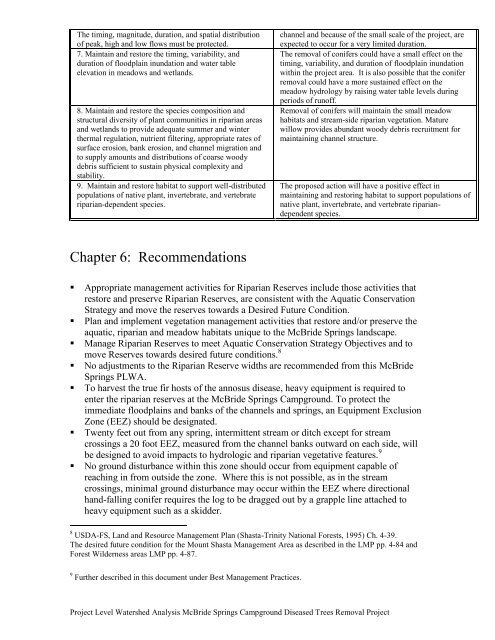Project Level Watershed Analysis McBride Springs Campground ...
Project Level Watershed Analysis McBride Springs Campground ...
Project Level Watershed Analysis McBride Springs Campground ...
You also want an ePaper? Increase the reach of your titles
YUMPU automatically turns print PDFs into web optimized ePapers that Google loves.
The timing, magnitude, duration, and spatial distribution<br />
of peak, high and low flows must be protected.<br />
7. Maintain and restore the timing, variability, and<br />
duration of floodplain inundation and water table<br />
elevation in meadows and wetlands.<br />
8. Maintain and restore the species composition and<br />
structural diversity of plant communities in riparian areas<br />
and wetlands to provide adequate summer and winter<br />
thermal regulation, nutrient filtering, appropriate rates of<br />
surface erosion, bank erosion, and channel migration and<br />
to supply amounts and distributions of coarse woody<br />
debris sufficient to sustain physical complexity and<br />
stability.<br />
9. Maintain and restore habitat to support well-distributed<br />
populations of native plant, invertebrate, and vertebrate<br />
riparian-dependent species.<br />
Chapter 6: Recommendations<br />
channel and because of the small scale of the project, are<br />
expected to occur for a very limited duration.<br />
The removal of conifers could have a small effect on the<br />
timing, variability, and duration of floodplain inundation<br />
within the project area. It is also possible that the conifer<br />
removal could have a more sustained effect on the<br />
meadow hydrology by raising water table levels during<br />
periods of runoff.<br />
Removal of conifers will maintain the small meadow<br />
habitats and stream-side riparian vegetation. Mature<br />
willow provides abundant woody debris recruitment for<br />
maintaining channel structure.<br />
The proposed action will have a positive effect in<br />
maintaining and restoring habitat to support populations of<br />
native plant, invertebrate, and vertebrate ripariandependent<br />
species.<br />
Appropriate management activities for Riparian Reserves include those activities that<br />
restore and preserve Riparian Reserves, are consistent with the Aquatic Conservation<br />
Strategy and move the reserves towards a Desired Future Condition.<br />
Plan and implement vegetation management activities that restore and/or preserve the<br />
aquatic, riparian and meadow habitats unique to the <strong>McBride</strong> <strong>Springs</strong> landscape.<br />
Manage Riparian Reserves to meet Aquatic Conservation Strategy Objectives and to<br />
move Reserves towards desired future conditions. 8<br />
No adjustments to the Riparian Reserve widths are recommended from this <strong>McBride</strong><br />
<strong>Springs</strong> PLWA.<br />
To harvest the true fir hosts of the annosus disease, heavy equipment is required to<br />
enter the riparian reserves at the <strong>McBride</strong> <strong>Springs</strong> <strong>Campground</strong>. To protect the<br />
immediate floodplains and banks of the channels and springs, an Equipment Exclusion<br />
Zone (EEZ) should be designated.<br />
Twenty feet out from any spring, intermittent stream or ditch except for stream<br />
crossings a 20 foot EEZ, measured from the channel banks outward on each side, will<br />
be designed to avoid impacts to hydrologic and riparian vegetative features. 9<br />
No ground disturbance within this zone should occur from equipment capable of<br />
reaching in from outside the zone. Where this is not possible, as in the stream<br />
crossings, minimal ground disturbance may occur within the EEZ where directional<br />
hand-falling conifer requires the log to be dragged out by a grapple line attached to<br />
heavy equipment such as a skidder.<br />
8 USDA-FS, Land and Resource Management Plan (Shasta-Trinity National Forests, 1995) Ch. 4-39.<br />
The desired future condition for the Mount Shasta Management Area as described in the LMP pp. 4-84 and<br />
Forest Wilderness areas LMP pp. 4-87.<br />
9 Further described in this document under Best Management Practices.<br />
<strong>Project</strong> <strong>Level</strong> <strong>Watershed</strong> <strong>Analysis</strong> <strong>McBride</strong> <strong>Springs</strong> <strong>Campground</strong> Diseased Trees Removal <strong>Project</strong>
















